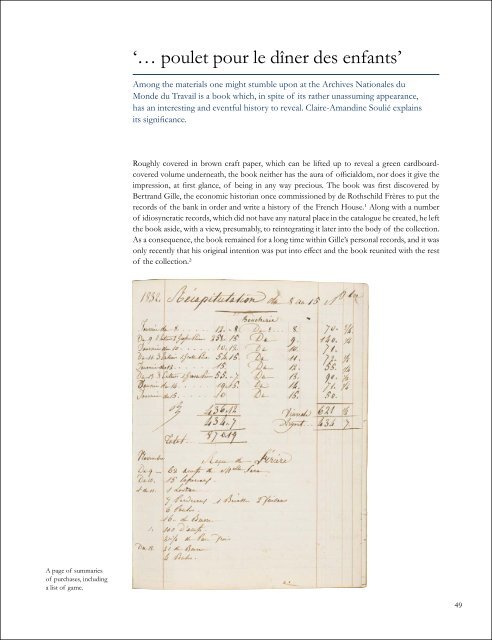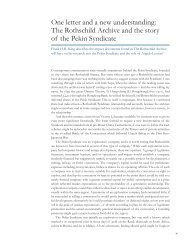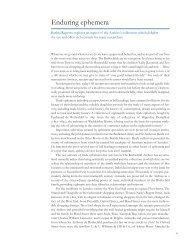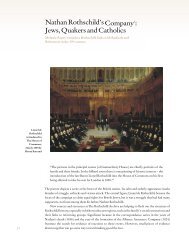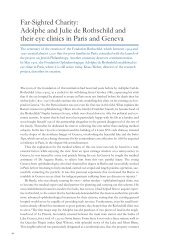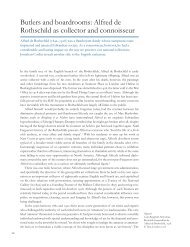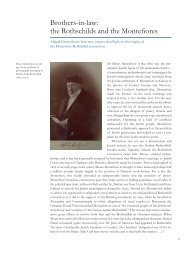'Poulet pour le diner des enfants': a Rothschild kitchen account book ...
'Poulet pour le diner des enfants': a Rothschild kitchen account book ...
'Poulet pour le diner des enfants': a Rothschild kitchen account book ...
Create successful ePaper yourself
Turn your PDF publications into a flip-book with our unique Google optimized e-Paper software.
‘… pou<strong>le</strong>t <strong>pour</strong> <strong>le</strong> dîner <strong>des</strong> enfants’<br />
Among the materials one might stumb<strong>le</strong> upon at the Archives Nationa<strong>le</strong>s du<br />
Monde du Travail is a <strong>book</strong> which, in spite of its rather unassuming appearance,<br />
has an interesting and eventful history to reveal. Claire-Amandine Soulié explains<br />
its significance.<br />
Roughly covered in brown craft paper, which can be lifted up to reveal a green cardboardcovered<br />
volume underneath, the <strong>book</strong> neither has the aura of officialdom, nor does it give the<br />
impression, at first glance, of being in any way precious. The <strong>book</strong> was first discovered by<br />
Bertrand Gil<strong>le</strong>, the economic historian once commissioned by de <strong>Rothschild</strong> Frères to put the<br />
records of the bank in order and write a history of the French House. ₁ Along with a number<br />
of idiosyncratic records, which did not have any natural place in the catalogue he created, he <strong>le</strong>ft<br />
the <strong>book</strong> aside, with a view, presumably, to reintegrating it later into the body of the col<strong>le</strong>ction.<br />
As a consequence, the <strong>book</strong> remained for a long time within Gil<strong>le</strong>’s personal records, and it was<br />
only recently that his original intention was put into effect and the <strong>book</strong> reunited with the rest<br />
of the col<strong>le</strong>ction.²<br />
A page of summaries<br />
of purchases, including<br />
a list of game.<br />
49
(opposite page)<br />
Children’s meals are<br />
recorded in these pages<br />
from the <strong>kitchen</strong> <strong>account</strong><br />
<strong>book</strong>.<br />
(pages 52 to 53, over<strong>le</strong>af)<br />
Entries in the <strong>kitchen</strong><br />
<strong>account</strong> <strong>book</strong> for 10 to 12<br />
November 1832, featuring<br />
Potage aux Vermicel<strong>le</strong>s à<br />
l’Al<strong>le</strong>mande, Venaison<br />
Anglaise, Saumon à<br />
l’Al<strong>le</strong>mande, Fi<strong>le</strong>t de Boeuf<br />
à la Napolitaine, Poitrine de<br />
Veau à l’Al<strong>le</strong>mande, Gâteau<br />
Napolitain.<br />
The <strong>book</strong>, which, in Gil<strong>le</strong>’s writing, is identified as a ‘Livre <strong>des</strong> comptes de cuisine’ [Kitchen<br />
Account Book] for the period 15 October 1832 – 15 September 1833, has no other formal label<br />
or any clue to information that might be contained inside. Browsing through its contents,<br />
though, is both interesting and entertaining as it records all the ingredients of the meals eaten<br />
by James de <strong>Rothschild</strong> and his family for a period of just over a year between 1832 and 1833.<br />
One regular entry, ‘pou<strong>le</strong>t <strong>pour</strong> <strong>le</strong> dîner <strong>des</strong> enfants’ signals that chicken was served to the<br />
children on most nights. However as one can imagine, the amount of entertaining and dinner<br />
parties that took place in rue Laffitte is ref<strong>le</strong>cted in the long lists of expensive ingredients, and<br />
records of lavish meals. Truff<strong>le</strong>s, lobsters, and champagne jelly, were at once on the menu of the<br />
dinner of 17 November 1832, along with count<strong>le</strong>ss, sophisticated accompaniments, and sweet<br />
delicacies for <strong>des</strong>sert. Browsing through the <strong>book</strong>, one cannot help but make amusing guesses:<br />
which statesman, which diplomat, which financiers, did they entertain, on the 11 and 12<br />
November 1832, for there to be so many foreign dishes on the menu? Potage aux Vermicel<strong>le</strong>s à<br />
l’Al<strong>le</strong>mande, Venaison Anglaise, Saumon à l’Al<strong>le</strong>mande, Fi<strong>le</strong>t de Boeuf à la Napolitaine,<br />
Poitrine de Veau à l’Al<strong>le</strong>mande, Gâteau Napolitain … all these mouth-watering dishes were<br />
served in these two days, but who were the honoured guests who merited this undoubtedly<br />
unique culinary experience? Who was sitting at the tab<strong>le</strong> for the dinner of 22 April 1833, when<br />
two soups were served, followed by eight starters, six main dishes with three different accompaniments,<br />
and eight <strong>des</strong>serts, including jellied pineapp<strong>le</strong> and champagne chocolate truff<strong>le</strong>?<br />
When it was first uncovered, the <strong>book</strong> was thought to have belonged to Antonin Carême,<br />
James’ chef, who had also been in the service of Tal<strong>le</strong>yrand, and is still recognised as one of the<br />
greatest French chefs of all time. Carême, however, had <strong>le</strong>ft <strong>Rothschild</strong> employment by the time<br />
this <strong>book</strong> was compi<strong>le</strong>d, and he died in January 1833, proving this assumption to be wrong. Can<br />
the banquets produced in succeeding years have been so very different, however, to that<br />
<strong>des</strong>cribed by Lady Morgan in 1830, at which she sat at a tab<strong>le</strong> tastefully laid with gold, silver and<br />
porcelain? There were, she recorded, no ‘old-fashioned, strong-tasting sauces, nor over-concentrated<br />
jus. Rather, the delicate gravies were made with almost chemical precision … each vegetab<strong>le</strong><br />
still had its fresh colour, … the mayonnaise was whipped ice cold.’³<br />
Neither the attribution of the <strong>book</strong> to a post-Carême era, nor its banal appearance should<br />
distract from how truly fascinating a volume it is, in documenting one of the most well-known<br />
aspects of <strong>Rothschild</strong> sty<strong>le</strong>: the art of hospitality.<br />
The <strong>book</strong> has now been digitised in its entirety and is availab<strong>le</strong> on the <strong>Rothschild</strong> Research Forum at<br />
www.rothschildarchive.org<br />
notes<br />
1 Bertrand Gil<strong>le</strong>, Histoire de la Maison <strong>Rothschild</strong><br />
(Genève: Droz, 1965).<br />
2 The <strong>Rothschild</strong> fonds conserved at the Archives<br />
Nationa<strong>le</strong>s du Monde du Travail carries the reference<br />
132aq.<br />
3 Georg Heuberger, ed., The <strong>Rothschild</strong>s, A European ,<br />
(Frankfurt am Main: Thorbecke / Boydell & Brewer,<br />
1994), p.105.<br />
50 51


